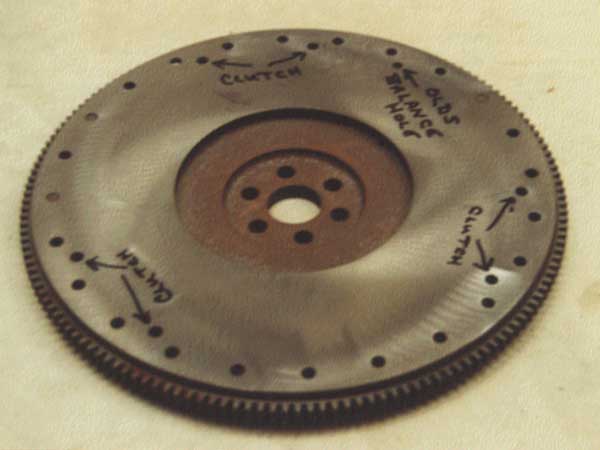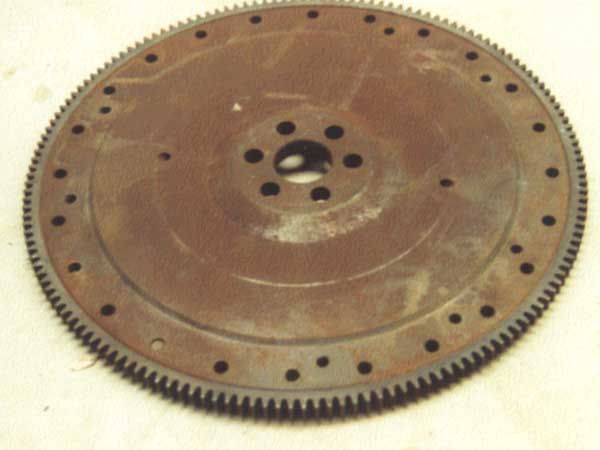
Oldsmobile "Light" version (extra balance hole is highlighted)
Buick and Oldsmobile 215 Flywheels
This article appeared in The British V8 Newsletter - Volume XIII, Issue 3 - September 2005
by: Kurt Schley
The OEM Buick and Oldsmobile 215 flywheels are very similar. All were manufactured from cast iron. The flywheels are 13.10" in diameter (not including the ring gear) and are drilled for the Long style 9-1/2" clutch with three pairs of 5/16 - 18 tapped holes on a 10-7/8" bolt circle. (The exception is the Oldsmobile Jetfire flywheel with a 11-3/8" bolt circle.) The flywheel i.d. at the crankshaft is 1.34" , inside of 6 each 0.47" diameter clutch to flywheel bolt holes on a 2.32" bolt circle. One of these six holes is offset slightly so that the flywheel can be mounted to the crankshaft in only one position, facilitating balancing. The friction surface to mate with the clutch disc is 10.00" for all except the Jetfire, which had a 10-1/2" clutch disc. The flywheels also are drilled with 1/4" diameter through holes at a 45° angle, located near the mounting bolt holes. These holes were to vent fumes and gases generated by the friction between the clutch disc and the flywheel. The Buick flywheels have three of these holes and the Oldsmobile units have two.
All of the OEM 215 flywheels were individually balanced. Around the circumference of
the flywheels were drilled a ring of 24 equally spaced holes on a 11.18" diameter
circle. The balancing procedure was a two phase procedure. After an initial spin on
the balancing machine, one or more metal pins were inserted into the ring of holes on
the flywheel periphery, if necessary, and staked permanently into place. This placed
the flywheel into a neutral or balanced state. The flywheel was then attached to the
crankshaft and the assembly spun again. If any imbalance in the flywheel/crankshaft
combination was present, additional balancing pins were installed as necessary. The
second set of pin(s) is a press fit and can be removed.
If the original flywheel on a 215 is damaged or worn, a replacement flywheel of identical
type can be installed without the need for balancing at a machine shop. Merely remove
the un-staked pins from the old flywheel and install them in the exact same location in
the replacement (If there were un-staked pins in the replacement flywheel remove them
before transferring pins from the old flywheel!) Do not attempt to transfer the staked
pins. Use the offset crankshaft attachment bolt to position the two flywheels identically
and determine the proper pin locations.
Buick - Buick employed two styles of manual flywheels, a light and heavy version. The
"light" version weighs in at only 23 lbs. and is flat faced on the clutch side. This
flywheel was supplied only in the 2-door 3-speed sedans which, because of their relatively
light weight, did not require a heavier flywheel to get smoothly in motion from a stop.
The balance of the Buick 215 powered cars, such as the 4-door coupes and the station
wagons, were built with a beefier flywheel. The "heavy" version flywheel incorporated
an integral cast inertial ring around it's circumference which boosted the weight to
32 lbs.
Oldsmobile - The Oldsmobile 215 flywheel inventory included two which were very similar
to the Buick versions, plus an intermediate weight flywheel for use in the turbocharged
Jetfire and in Oldsmobile sedans supplied to police departments. The reduction in weight
was accomplished by machining of the inertia ring of a "heavy" version flywheel down to
only a 1/4" width. In addition to its weight, the intermediate flywheel was unusual in
that it was drilled for a 10-1/2" clutch. Oldsmobile engineers figured that the Jetfire's
210HP and constant abuse of police patrols suggested need for a larger clutch to provide
an acceptable service life.
|
Enjoying this article? Our magazine is funded through the generous support of readers like you! To contribute to our operating budget, please click here and follow the instructions. (Suggested contribution is twenty bucks per year. Feel free to give more!) |
The drivetrain engineers at Oldsmobile also incorporated a refinement which physically differentiates the Olds from the Buick flywheels. Early testing of the 215 engine revealed a very slight rocking motion when idling. Numerous tests determined that this movement could be eliminated by drilling a single additional balancing hole 0.25" diameter x 0.7" in depth in the flywheel, 5.32" from the center of the flywheel and just inboard of the standard ring of balance pin holes. The Oldsmobile harmonic balancer was redesigned to incorporate a small cast-in rib whose weight offset that lost to the flywheel's balancing hole. The slight imbalance induced by the hole in the flywheel worked in synergy with the redesigned harmonic balancer to eliminate the engine rock and afford an overall smoother running engine.
Pontiac - To accommodate the 215-powered Pontiac Tempest's unusual drivetrain, a flywheel unique to the Tempest was designed. This flywheel was flat-faced and heavy at 40 lbs. Unlike the Long-style clutch drilling used by Buick and Olds, the Pontiac flywheel is drilled for a Borg and Beck clutch. Flywheel Ring Gear - The flywheel ring gear was manufactured with 156 teeth and is a shrink fit on the flywheel which makes replacement relatively easy. To remove a worn or damaged ring gear, two 3/16" holes are drilled, one side to side between two teeth and another intersecting hole from the outside in, and the gear is split at the holes with a sharp chisel. The new ring gear is then heated with a torch or in the oven to expand its diameter. While hot, the gear is pressed onto the flywheel, making sure that it is aligned with the flywheel face and with the chamfered edge of the ring gear against the flywheel shoulder. OEM specifications call out that the ring gear must withstand 28,000 inch/pounds of torque without slipping.
| Partial List of General Motors 215 Flywheel Part Numbers: | ||
| Year | Model | Part Number |
| 1961 | F85 Manual transmission (except Heavy Duty models) | 578340 |
| 1961 | F85 Manual transmission (Heavy Duty models) | 583061 |
| 1961/62 | F85 (except Jetfire) | 586998 |
| 1962 | F85 Police and Taxi | 588457 |
| 1962 | Jetfire | 588457 |
| 1961/62 | Special | 1199441 |
Buick 300 Flywheel:
* Drilled for Borg-Warner clutch, 3 equally spaced 3/8-16 UNC holes on 11-5/8" bolt circle
* 6 ea. 0.46" diameter flywheel-to-crank bolt holes on 3.580" bolt circle
* 3 ea. vent holes
* 166 tooth ring gear

Oldsmobile "Light" version - backside

Heavy Buick Flywheel
(editor's note: that ring around the outer edge is even deeper than it appears in the photo)
Disclaimer: This page was researched and written by Kurt Schley. Views expressed are those of the author, and are provided without warrantee or guarantee. Apply at your own risk.

